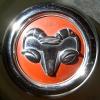If the piston rings are not sealing against the bore walls, any wear on the rings or bore can allow exhaust gas from combustion to escape into the crankcase before being forced out through the exhaust valve...the draft tube and filtered crankcase fill cap allow this smoky buildup to escape to atmosphere so that pressure does not build up and blow out the rear main and timing chain cover seals. During normal operation, the draft tube system is supposed to draw out excess gases from blowby or steam forming from condensation in the crankcase but only when the vehicle is in motion; when the vehicle is not moving or moving at low speeds, no vacuum is present at the tip of the draft tube, so those gases escape out thru the filtered crankcase fill cap. But if a PCV system is installed, these excess gases would be drawn into the charge air system at all times, burning off hydrocarbons and keeping the smelly cloud from forming in the engine compartment...
additional information - grey beard's PCV installation and modifications




